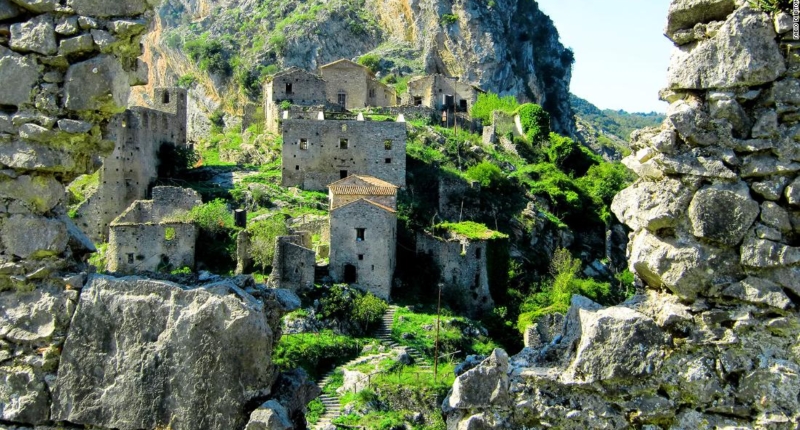San Severino di Centola, one of roughly 6,000 abandoned villages dotted around Italy, has been bought by a group of Italian professionals and a foreign entrepreneur with the hope of preserving the town’s original beauty. The town’s ruins include collapsing pieces of architecture dating back to the Longobards, and the Normans. The village is made up of different historical layers, once built to control the entire coast, it’s now an ideal day trip destination for holiday makers staying on Cilento’s buzzing coast. The old houses based on the rocky crest were difficult to access, so the remaining inhabitants of the village began to move further downhill as the others left. Wild goats are frequently spotted among the ruins, along with parts of an abandoned old railway covered in moss. The ghost hamlet, even though it is mostly private, is open year round with free entry and each year draws some 50,000 tourists, mostly in summer when they come seeking coolness to escape the hot beaches.
Reviving San Severino di Centola
Locals in the small Italian village of San Severino di Centola have taken on the ambitious task of reviving the neglected hamlet, which has been abandoned since the 1970s. The group, which includes retired banker Silverio D’Angelo and eight others from different parts of Italy, purchased all the neglected homes in the medieval district of the village in 2008, making a strong emotional investment in the place.
D’Angelo and his team decided to take matters into their own hands after becoming worried that unscrupulous investors would buy the properties and significantly alter the village’s structure. They aimed to save the village while preserving its unique character.
“We have a strong attachment to this land, our hearts belong here. But it was quite a reckless move. You need a lot of patience, and money, to bring a whole place like this back to life,” said D’Angelo, who was born in the newer section of the village.
The new owners are determined to revive the village, but without exploiting it. They believe that it’s better for the village to crumble naturally than to be exploited by outsiders. The owners hope to attract new residents to the village by restoring the abandoned homes and maintaining the village’s authenticity.
Revitalizing shrinking Italian villages
The trend of buying abandoned properties in shrinking Italian towns has been growing in popularity over the past few years, with many towns selling neglected homes at bargain prices. Sambuca di Sicilia is a prime example, with the town attracting attention for its “one-dollar houses.”
However, the owners of San Severino di Centola have taken a step further by purchasing an entire hamlet. The village is located in the Province of Salerno, Campania, and has been neglected for decades.
The new owners have a strong emotional attachment to the village and believe that it’s their responsibility to revive it. Around 350 people live in the newer section of San Severino di Centola, which is a 15-minute walk away from the abandoned area. The owners acquired approximately 60 old stone dwellings 15 years ago, and each has a property stake.
Reviving the village will require patience and a lot of money, but the owners are determined to make it work. They hope to restore the village’s unique character while also attracting new residents to the area.
Reviving San Severino di Centola: Preserving the Village’s Beauty
The group of Italians who purchased the abandoned hamlet of San Severino di Centola in 2008 have no grand plans to turn it into a lavish resort or holiday retreat, but rather to preserve the original beauty of the village by reviving its decaying houses and monuments. The village, located in the Province of Salerno, Campania, has been abandoned since the 1970s and is one of roughly 6,000 ghost hamlets or villages around Italy.
Silverio D’Angelo, one of the village’s “rescuers,” explains that the group was driven by a love for the place and a desire to save it from unscrupulous investors who could have altered its unique structure. “It breaks my heart to see the ghost hamlet fall to pieces and into oblivion, and that just a tiny part of it has been restyled,” says D’Angelo. “We want to make it entirely accessible and safe for visitors.”
While the new owners have not disclosed how much they paid for the village, they consider their purchase to be an “ambitious rescue mission.” The group believes that it’s better to preserve the village, even if it crumbles, than to let it be exploited by outsiders.
San Severino di Centola: A Place of the Heart and Mind
PR consultant Monica Gillocchi, another of the village’s “rescuers,” describes the experience as a crazy adventure. Gillocchi, the daughter of a San Severino di Centola resident, frequently returns to the village and never tires of walking up to San Severino, which she calls a “place of the heart and mind.”
The attachment to the place is strong for all the inhabitants, including those who have moved to other places for work but whose hearts belong in San Severino di Centola. Gillocchi explains that many people from the town or children of local natives return to San Severino every year to find their origins and imagine what the lives of their ancestors could have been like in the past.
According to D’Angelo, the group has been sitting on their investment for years due to a lack of resources and bureaucracy issues. So far, only the castle, the path leading up to it, and the little piazza have been restyled with public funds. The new owners hope to attract new residents to the village by restoring the abandoned homes and maintaining the village’s authenticity.
Reviving “Sleeping Beauties”
San Severino di Centola is just one of many ghost hamlets or villages that have been left deserted in Italy due to natural disasters or migration. Italians call them “sleeping beauties” and many believe they are simply waiting to be “awoken” or revived by determined rescuers, whether they be investors or locals with nostalgic family connections.
The new owners of San Severino di Centola are determined to revive the village while preserving its unique character. The village is surrounded by pristine ragged hills, forests, and streams and the new owners hope to make it entirely accessible and safe for visitors. Reviving the village will be an ambitious undertaking, but the group believes it’s their responsibility to save the village from disappearing into oblivion.
San Severino di Centola, a decaying Italian hamlet located in the Province of Salerno, Campania, is being revived by a group of locals who bought the entire village back in 2008. The village has been pretty much abandoned since the last residents left in the 1970s, and the group of Italians, originally from San Severino, purchased all of the neglected homes in the medieval district of the village. The group bought the ghost hamlet to take it off the market without necessarily doing anything with it, with no grand plans to turn the hamlet into a lavish resort or holiday retreat spot with residences, but simply to preserve the village’s original beauty by breathing new life into its decaying houses and monuments. The group hopes to make it entirely accessible and safe for visitors, and D’Angelo describes their investment as an “ambitious rescue mission.”
San Severino di Centola is one of roughly 6,000 abandoned ghost hamlets or villages dotted around Italy that have been left deserted due to natural disasters or migration. These ghost villages are often set in breathtakingly beautiful spots, and many feel that they are simply waiting to be “awoken,” or revived by determined rescuers, be they investors, or locals with a nostalgic family connection. San Severino di Centola, located in the pristine Cilento National Park, is an ideal day trip destination for holiday makers staying on Cilento’s buzzing coast and comes alive on weekends and during summer time.
While the group of locals that purchased San Severino di Centola has been sitting on their investment for years, mainly due to a lack of resources and bureaucracy issues, they acquired around 60 old stone dwellings 15 years ago, and each member has a property stake. So far, the only parts of the village that have been restyled with public funds are the imposing castle, the path leading up to it, and the little piazza, where painting exhibitions, poetry labs, concerts, and real-life nativity scenes are staged at Christmas. The old village is made of different historical layers of collapsing pieces of architecture dating back to the Longobards, believed to be among the first settlers, and the Normans.
The ghost hamlet, even though it is mostly private, is open year-round with free entry and draws about 50,000 tourists each year, mostly in summer when they come seeking coolness to escape the hot beaches. Visitors can also take tours of the area that include visits to the ruins of a cathedral, a chapel, a lookout tower built against enemy raids, an imposing aristocratic palazzo once belonging to the local lords, and a migrant’s museum showcasing some of the belongings of the families who started abandoning the village in the 1800s in search of a brighter future abroad, including the US.
The group of locals hopes to find eco-conscious investors willing to carry out an environmentally friendly restyle of the village, but for now, they are happy to own and protect the ghost place as it is. According to D’Angelo, the group doesn’t want the old village to fall into the wrong hands, which would have destroyed its very nature. He also points out that most people who visit San Severino di Centola come back, and it’s a “place of memory” that their goal is to valorize in the best possible way.
The hamlet of San Severino di Centola is a beautiful and historic village situated in the Cilento National Park in Southern Italy. Unfortunately, most of its empty stone dwellings have collapsed roofs, holes where windows used to be, and unhinged doors. The village has been bought by a group of Italians who wish to breathe new life into it without exploiting it. They hope to preserve the village’s original beauty by giving it a small-scale sustainable makeover, which would bring out its uniqueness. The group has been sitting on their investment for years due to a lack of resources and bureaucracy issues. The village could host artisan boutiques or art labs or turn into tiny scattered rooms for a few guests that blend in with the surroundings. The goal is to valorize the village in the best possible way and to protect it from abandonment because these old villages are the backbone of Italy.
Don’t miss interesting posts on Famousbio








